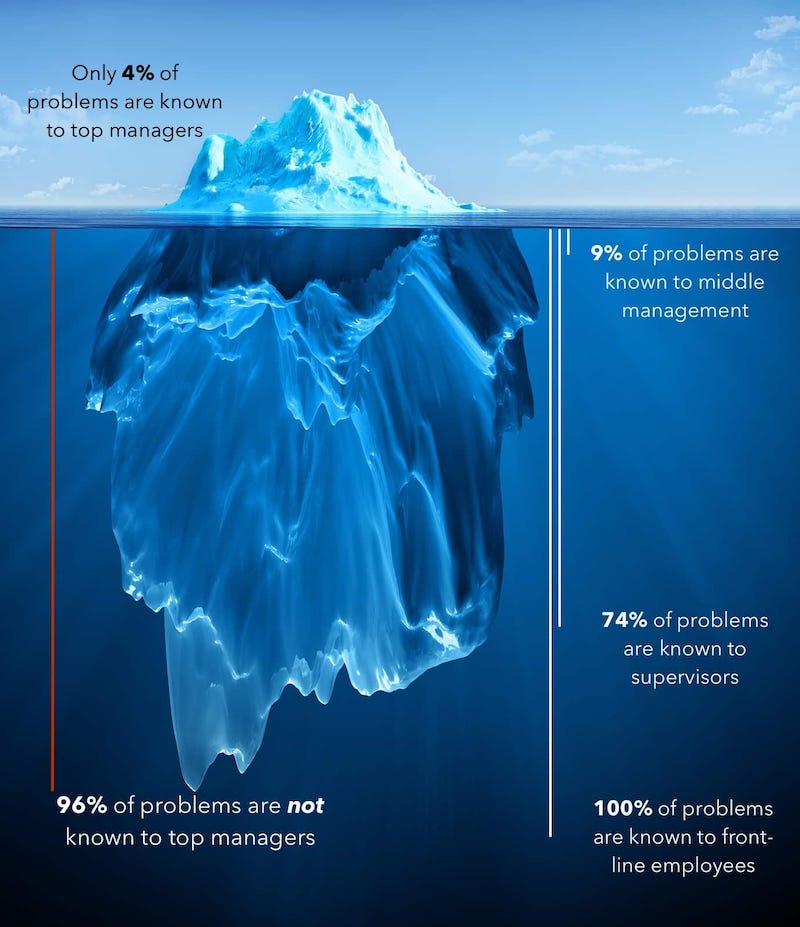There are three sides to every story: your side, my side and the truth. And no one is lying.
That Robert Evans quote has always stuck with me. It’s a simple yet somewhat profound insight into the fact that perception matters. It acknowledges that we each can have different perceptions of the same subject and both be right. #somebodytellmywife
Leadership perspectives may be different than their employees’.
Remember that game called Telephone that we used to play as kids? Where one kid comes up with a phrase and whispers it in the ear of another. That kid then whispers it to the smelly kid next to them and it continues around the circle, one stinky kid to another, until it’s back with the originator. Usually the final version is a poor, hopefully humorous, rendition of what was initially said.

The lesson from that game is that the further removed you get from the message, the more diluted it becomes.
Not that any kids have actually learned that lesson from Telephone. For kids, it’s mostly just about laughing. But when those kids get a few decades older and begin writing a newsletter about leadership, they’ll finally realize the lesson. You know, hypothetically. Speaking for a friend.
Regardless of when it’s learned, the Telephone lesson is a good one, mostly because it’s true.
The more degrees of people you are removed from a message, the less likely you will hear about it or understand it’s true meaning.
This is pretty darn evident, and can be pretty darn impactful, in the workplace.
When The Leadership Perspective Was Fake
I once worked with a company that had grown rapidly into being an industry leader. They continued to innovate, albeit a bit slowly, and were on the verge of being acquired.
The CEO had a bunch of energy and in the all-staff meetings told the employees how amazing everything was and how grateful he was for them and how they were ushering in a new phase of the company.
He was honest and excited.
He asked if anybody had questions, but the employees rarely asked any, so he told the staff he had an open door policy and they should never hesitate to talk to him.
He went to sleep every night with a smile on his face, knowing that the company was headed in the right direction and the employees were happy.
But, alas, his leadership perspective was wrong.
Employees were walking away from the all-staff meetings feeling discouraged. They thought the CEO was a fake. They thought he was just pretending that the problems would go away if he just ignored them. Because there were problems. Meaningful problems. Problems so big that people were looking for new jobs.
From the employees’ perspectives, the company was in shambles.
Despite their growth, budgets kept getting slashed which led to greater employee workloads. Despite their current position in the market, new products were not being developed as fast as the competitors. Despite the chance of being acquired, employees didn’t understand the vision of the company and why they were working so hard.

The Actual Leadership Perspective
You may wonder why the CEO, who came to the meetings with genuine excitement, didn’t pick up on all the issues.
It’s because of a different perspective.
You see, from the CEO’s leadership perspective, it was logical. Budgets had to be tightened in order to increase the company’s value.
Innovation had slowed because they had to prove they could generate more revenue from existing products.
The company vision was not reinforced because the leader was spending all his time on the acquisition, which was more important for the long-term health of the organization.
Everything from the leadership perspective was purposeful, all geared towards achieving the desired outcome and growing the company. The CEO assumed everybody knew and understood the leadership’s perspective. The CEO was wrong.
As for the employees, they were miserable and they all assumed that the CEO knew and understood their perspective. The employees were wrong.
Let me repeat:
There are three sides to every story: your side, my side and the truth. And no one is lying.
In this case, both the CEO and employees were correct in their perception of the company – despite the fact that they had seemingly opposing perceptions.
The Iceberg of Ignorance
In 1989, Sidney Yoshida conducted a study about corporate behavior. The most recognized takeaway from his study was his creation of the Iceberg of Ignorance.
Here is what Sidney recognized:
- Only 4% of problems are known to top managers. That means 96% of a company’s problems are not even on the radar of top management
- 9% of problems are known to middle management
- 74% of problems are known to supervisors
- 100% of problems are known to front-line employees
This is a wonderful image to put it all in perspective:

Incredible, right?
Keep in mind, this concept was brought forth in 1989. That was 32 years ago. A lot has changed since then. However, as life would have it, the Iceberg of Ignorance has not changed that much. Senior leaders are still ignorant of the vast majority of company problems.
ThinkWay did a survey in 2015 that confirmed there still exists a significant knowledge gap between senior execs and the rest of an organization.
As an example, according to their results, 61% of executives and general management said that their organizations had “efficient, effective processes with minimal waste and bureaucracy.”
However, only 27% of the rest of employees agreed with that statement.
In other words, two thirds of the leadership perspectives tend to believe a company is productive but 75% of the front-line employees disagree with them.
That’s an enormous gap in communication.

Get Under The Iceberg
The fact remains that senior leadership perspectives and front-line employee perspectives on a company will probably always be different. That is normal. They are doing different jobs and have somewhat different day-to-day goals.
And as we learned from the game of Telephone, the further removed a senior leader is from their front-line workers, the less understanding they will have of the issues.
That said, there are four things that senior leadership can do in order to reduce the size of the Iceberg of Ignorance and build trust among all employees.
However, I’ve talked enough for now. You can read the rest here.
A Somewhat Relevant Quote
“Leaders who don’t listen will eventually be surrounded by people who have nothing to say.“
Andy Stanley, author, pastor
Random News
105 and Running – A 105 year old woman just set the world record for the 100m run
e-Classic – A mechanic is converting classic cars to electric cars
Don’t Read This – A guy was having mysterious seizures so he went to the hospital and, well, you don’t want to know
Another Useless Website – This is what a million laughs looks like

